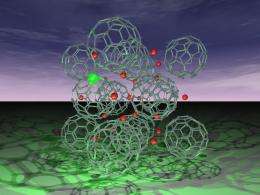Muon implanted into face-centred cubic Cs3C60
Researchers from the Universities of Liverpool and Durham have fitted another piece into the superconductivity puzzle that could help in the quest to bring down the cost of technologies such as MRI scanners and some energy storage applications that rely on superconductors. The result is published online in the journal Nature (19th May 2010).
Using the ISIS and Diamond Facilities at the Science and Technology Facilities Council's Rutherford Appleton Laboratory (RAL) and the European Synchrotron Radiation Facility (ESRF) in Grenoble, scientists have demonstrated how a new material made from metal atoms and buckyballs (tiny carbon-60 molecules shaped like a football) becomes a high temperature superconductor when it is squashed. The applied pressure shrinks the structure and overcomes the repulsion between the electrons, allowing them to pair up and travel through the material without resistance.
The Liverpool and Durham researchers made the new material supported by funding from the Engineering and Physical Sciences Research Council for a program investigating ways of creating higher temperature superconductors, to reduce some of the costs involved with keeping them at their optimum temperature and broaden their applications. An MRI scanner for example, contains person-sized superconductive magnet that needs to be kept inside a bath of liquid helium in order to regulate the superconductor's temperature at - 270 degrees Celcius. The ultimate aim is for a superconductor to operate at room temperature to eliminate the need for large and expensive cooling systems.
Dr Peter Baker, Muon instrument scientist at STFC's ISIS Facility6: "This research suggests that there is a universal trend in high temperature superconducting materials, which is a great step forward in understanding the fundamental nature of superconductivity. Once we know how superconductivity works it will be easier to develop high temperature superconducting materials with specific properties, opening the door to new applications and ultra efficient energy transmission."
The advantage of investigating carbon-based superconducting materials is that they can be made with different structures that alter their properties; whereas the active components of other high high-temperature superconductors, such as copper oxide materials, are always arranged in one way. This structural flexibility offers a new way of looking at the mechanisms that drive high-temperature superconductivity, offering more insight into how to make higher temperature superconductors. It has also established a universal pattern in the superconductivity of carbon-based materials which can now be used to help guide future theoretical models of superconductivity.
Matthew Rosseinsky, Professor of Inorganic Chemistry, University of Liverpool said; "We've shown for the first time how controlling the arrangement of molecules in a high temperature superconductor controls its properties. This is possible because we have found two arrangements of the same basic molecular unit which have both superconducting and magnetic properties."
Kosmas Prassides, Professor of Chemistry, Durham University said; "This is important in the context of high-temperature superconductivity as it allowed us to see at which point superconductivity emerges out of the competing insulating state irrespective of the exact atomic structure - something that has not been possible before for any other known material".
More information: Paper: 'Polymorphism control of Superconductivity and Magnetism in Cs3C60' can be found at www.nature.com
Provided by European Synchrotron Radiation Facility



















